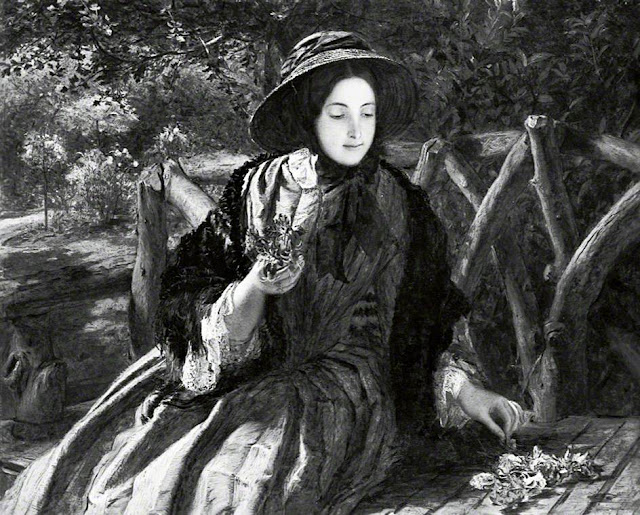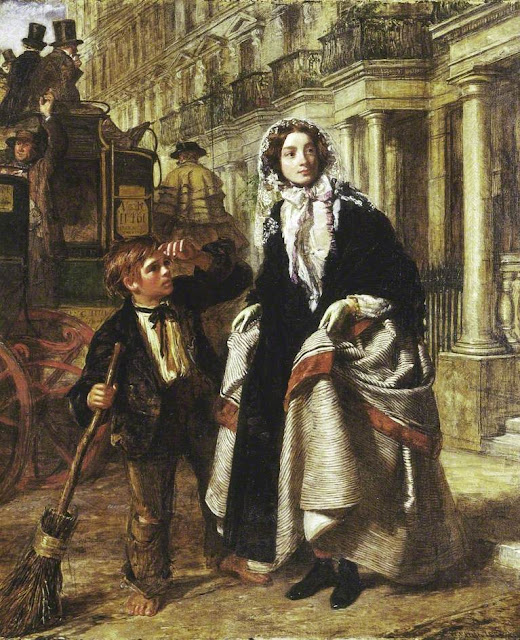William Powell Frith / English painter /born 1819- died 1909
WILLIAM POWELL FRITH was born in Yorkshire, where his father a self-made man had become a prosperous innkeeper in Harrogate. He had two brothers and a sister. It would seem that Frith senior was ambitious for his talented son, not surprisingly, given his own early life in domestic service. Contrary to comment made elsewhere, Frith's father was an affectionate parent, who had a good relationship with his son. In March 1835 Young Frith, accompanied by his father, and carrying a large portfolio of his drawings boarded the stagecoach to London. It is fascinating to record that the scheduled time for this journey was twenty four hours, just before the dawn of the railway age. Once established in London the young painter attended Sass's Academy, where he was rigorously trained in the basic techniques of panting. He later attended the Royal Academy Schools.
Frith's early paintings were mainly historical genre. He became part of a group of slightly younger artists who called themselves 'The Clique.' Fellow members of this group were Richard Dadd, the fairy painter who later became insane and killed his own father, Augustus Egg, H.N. O'Neil, and John Phillip.
Frith worked diligently, and success came early. He became ARA in 1845, and a full Academician in 1852. In 1851 the painter visited Ramsgate, the result of this being the first of his famous large scale crowd scenes Ramsgate Sands, which after over three years work was exhibited at the RA in 1854, and bought by Queen Victoria-Frith was a successful artist overnight. He received a large sum for the painting, but failed to keep all the rights to income from it, such as the sale of engravings. This was an error that the commercially astute painter did not repeat. Frith continued in this vein with Derby Day, 1858, The Railway Station, 1862, and Private View at The RA, of 1883. These pictures form a valuable record of life in Victorian England, and must have been the result of a stupendous amount of work. Frith seems to have been drawn towards crowds in his private as well as his artistic life. He lived in Bayswater, with his wife Isabelle, with whom, unfortunate woman, he had twelve children. Not content with this the fruitful Frith established another family only a mile away with Mary Alford, with whom he ultimately had seven more children. For a considerable time Isabelle Frith was in blissful ignorance of her husband's extra mural activities. Her suspicions became aroused, however, when she saw her husband posting a letter near their home, when he was supposed to be on holiday in Brighton. Following the death of Isabelle in 1880, Frith married his mistress. If he then started yet another family with yet another woman, I have been unable to establish, but perhaps by then time had cooled his ardour! It is worth noting that the artist was a popular, genial figure, with a reputation for helping younger artists.
In 1863, Frith was informed by Sir Charles Eastlake, President of the Royal Academy, that the Queen wished him to paint a picture of the forthcoming wedding ceremony of her son the Prince of Wales and Princess Alexandra of Denmark. Frith duly painted the picture for a fee of three thousand pounds, and it involved more than a year's concentrated work. He had felt compelled to undertake this commission and actually charged the Queen less than he would have charged another patron. Logistically the execution of picture of the picture was a nightmare, as members of the Royal Family had problems attending their sittings due to their heavy commitments. Many of the other aristocratic sitters had the same problems in attending, caused in large part by their arrogance and stupidity. It is a pleasure note that Frith was quite capable of repaying their arrogance with like behaviour, by the simple expedient of telling them that he would have to inform the Queen of their failure to attend. This he did in a very straightforward manner! The date of the Royal Wedding was 10th March 1863, the occasion being marked with much enthusiasm and popular rejoicing.
Frith, not surprisingly, used photographs as an aid in painting these large canvases.
Following the Private View at the Royal Academy, in 1883 the artist's output, and, the quality of his work started to decline. Frith then started to concentrate on writing his reminiscences at considerable length - and very good they are too. He also wrote the biography of John Leech (1817-1864 humorous artistic contributor to Punch).
A Contemporary View of W P Frith In His Seventies.
The Pall Mall Gazette 1892.
Mr W. P. Frith's many admirers will be glad to learn that there is one canvas at Burlington House this year bearing his signature. It is entitled The New Model, and will be found in gallery 1X. Mr Frith is now one of the four Honorary Retired Academicians; that is to say that he retains the honour of affixing RA to his name, has the right of sending four works to the Summer Exhibition, and possesses nearly all the privileges with none of the responsibilities of a full-blown Academician. He is the only retired member who has sent anything to the exhibition; since Mr Calder Marshall, Mr Pickersgill, and Mr George Richmond do not exhibit. Mr Frith, as everybody knows, was for at least a quarter of a century the most popular painter in this country. Of later years he has not done so much in the way of painting, but has devoted a great deal of his leisure to literary work, in the shape of an entertaining volume of reminiscences, and a life of John Leech. He is over seventy; but has nothing of old age about him beyond his years and a whitened head.
William Powell Frith died in 1909.
Sources: Various. The prime source for information about The Marriage of the Prince of Wales, was the late Jeremy Maas's excellent book The Prince of Wales's Wedding
Source: Victorian Art in Britain.




































































































ليست هناك تعليقات:
إرسال تعليق